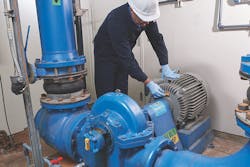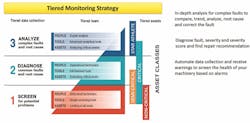Vibration monitoring for industrial water equipment
Many areas in industrial plants and other facilities depend on continuous water flow for proper processing and equipment health, including cooling towers, boiler feedwater and safety (eyewash/showers). Most industrial processes’ lifeblood may be water. It is used as an ingredient, a coolant, a cleaner, and in the oil and gas industry, a method for enhanced oil recovery. If the flow of water is impeded in any way, operations may come to a halt.
When equipment fails in these systems, problems often occur far down the line from the failed asset. How do teams efficiently and cost-effectively monitor for and mitigate failures of assets that are often not seen as highly critical?
Connected reliability
Connected reliability gives teams who are managing water and wastewater in facilities a roadmap for moving past incremental gains to making a quantum leap to an ideal maintenance and reliability setup. For proactive strategies, a connected reliability framework must consist of three essentials: comprehensive data collection, end-to-end connectivity and empowered teams.
The framework must also meet teams where they are in the journey. Most maintenance and reliability teams are using a combination of maintenance strategies with scheduled routes and some remote monitoring as part of the mix. Any method of data collection should be possible to achieve a more comprehensive maintenance and reliability strategy.
The principal component for comprehensive data collection
Connected tools and sensors — such as power monitors, thermal imaging sensors and connected handheld tools — with condition monitoring software provide information on asset health. Sensors and tools that send data to one location in the cloud or to an enterprise system can help mitigate many problems.
“Vibration monitoring is one of the key parameters to measure for the earliest notification of equipment problems.”
Vibration monitoring is one of the key parameters to measure for the earliest notification of equipment problems. Some vibration sensors screen for abnormal conditions in rotating equipment. Screening is an important part of a tiered maintenance approach (see Figure 2) and allows for cost-effective monitoring of lower tier or lower criticality equipment.
Figure 2. Screening, diagnosing and analyzing are all forms of vibration monitoring. Vibration screening offers the greatest initial value by providing a simple, scalable way to extend asset coverage, reduce routes and minimize labor costs.
The four common faults of rotating machines
Vibration screening with triaxial sensors can detect abnormalities caused by the four primary faults that may result in damaged or failed rotating assets.
Misalignment
Misalignment results in worn or failed bearings and other wear and damage. In worst-case scenarios, it may cause cracked or broken shafts, which can be personnel safety hazards as well as problems for the asset. Misalignment may be caused by many issues, including:
• Improper shaft installation
• Foundation or baseplate issues
• Improperly installed bearings
• Improperly coupled machinery
• Unbalanced loads
• Coupling damage
• Seal or bearing wear
Imbalance
If an asset experiences imbalance in any way (pump impeller or uneven foundation), vibration will occur with an adverse effect on the asset’s performance and efficiency. In time, the imbalance will cause failure. If the foundation is uneven or if one of a motor’s feet is uneven, soft foot can occur, causing excess vibration. Left unchecked, imbalance can also lead to cracked or broken shafts. Imbalance may be caused by:
• Eroded impeller blades
• Problems with motor rotors
• Improper bearing installation
• Bent shaft
Looseness
The shaft, foundation or any component may become loose. This looseness causes forces that lead to vibration and increased wear. It may also cause baseplate problems, loose bolts, cracks in a frame or improper fit between components, including pump impeller clearances. Looseness may be caused by:
• Improper installation
• Manufacturing defects
• Baseplate problems
• Improperly torqued fasteners
• Underlying vibration from other faults
Bearing wear
Bearing wear is often caused by other factors acting on the bearings. If the bearings are failing prematurely, the other low-level faults (imbalance, misalignment or looseness) may be the cause. Other causes of bearing wear are:
• Contamination
• Improper lubrication
• Improper installation
• Electrical damage
Overall vibration severity scale
Some vibration sensors require that the end user set up vibration thresholds for alarms. Other sensors provide a scale via software so that end users do not need vibration expertise to use the sensors. An overall vibration severity (OVS) scale developed over many years of vibration data allows some sensors to automatically access the vibration parameters from many machine categories. Many OVS scales provide actionable insights by taking overall vibration (OV) measurements on a machine in a frequency band of 10 to 1,000 hertz to screen for the most common machine faults.
One scale is based on the vibration severity developed by vibration experts monitoring thousands of machines over many years. They have determined the acceptable and nonacceptable OV levels for 37 different machine categories. This information provides automatic alarming thresholds and asset health ratings to allow users to quickly determine if a machine is healthy or needs further evaluation.
Ideal asset candidates for vibration monitoring
Pumps
• Vertical pumps
• Horizontal centrifugal pumps (direct-coupled)
• Boiler feedwater pumps (turbine- or motor-driven)
• Positive displacement horizontal piston pumps (under load)
• Positive displacement horizontal gear pumps (under load)
Fans
• Belt-driven fans (1,800 to 3,600 rpm and 600 to 1,799 rpm)
• General direct-drive fans (direct-coupled)
• Shaft-mounted integral fans (extended motor shaft)
• Axial flow fans (belt- or direct-driven)
• Large forced draft fans (fluid film bearings)
• Large induced draft fans (fluid film bearings)
• Vacuum blowers (belt- or direct-driven)
Compressors
• Reciprocating chillers (open motor, hermetic motor and compressor)
• Reciprocating air compressors
• Rotary screw air compressors
Centrifugal chillers (hermetic or open motor)
• Centrifugal air compressors with or without a gearbox
• Centrifugal air compressors — internal gear (axial measurement or radial
measurement)
Blowers
• Lobe-type rotary blowers (belt- or direct-driven)
• Multistage centrifugal blowers (direct-driven)
Cooling tower drives
• Long, hollow-shaft (motor)
• Belt-drive (motor and fan — all arrangements)
• Direct drive (motor and fan — all arrangements)
Generic gearboxes
• Single-stage gearboxes
Conclusion
Triaxial vibration sensors on water-handling assets throughout a facility — perhaps initially focusing on problem equipment to determine the best way to improve their operations — provide important data. The data can inform maintenance and reliability teams about abnormalities caused by the four major mechanical faults before asset damage or failure. Application is simple, and setup can typically be completed in under an hour. All rotating machines experience vibration. Pumps, fans and motors have different faults, and vibration screening can identify abnormal conditions caused by these faults. Easy-to-install sensors become a first line of defense and an early warning of conditional changes.


